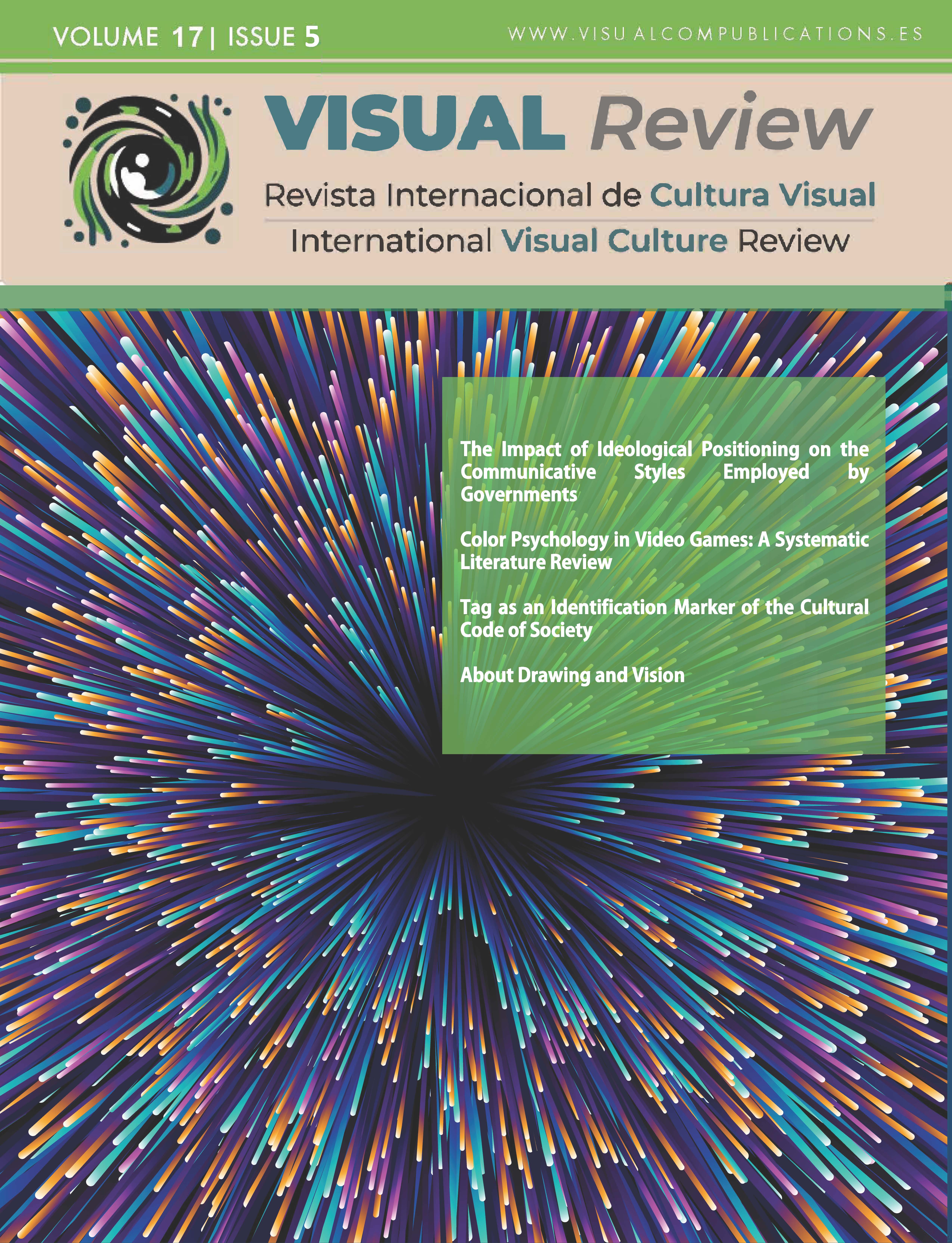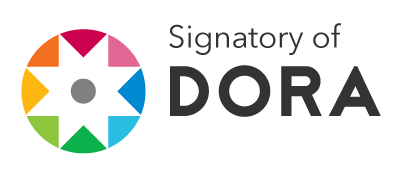La Etiqueta como Marcador de Identificación del Código Cultural de la Sociedad
DOI:
https://doi.org/10.62161/revvisual.v17.5774Palabras clave:
Etiqueta, Marcador de identificación, Graffiti, Señal, Código cultural, Arte callejero, Forma tipográfica, Entorno visualResumen
El artículo examina el tag como marcador de identificación de los códigos culturales en la sociedad y como herramienta de autoidentificación autoral dentro del entorno urbano contemporáneo. La investigación analiza las prácticas visuales de etiquetado mediante cuatro tags clave (#NoWar, #ClimateStrike, etc.) y tres casos regionales. Los hallazgos revelan que los tags no funcionan solo como elementos visuales, sino como herramientas multidimensionales que combinan estética, comunicación e interacción social. Se destaca la interacción de los símbolos visuales con las dimensiones culturales y sociales de los espacios urbanos digitales. El estudio amplía la comprensión del rol del tag y ofrece valor práctico para académicos y profesionales de la cultura visual contemporánea.
Descargas
Estadísticas globales ℹ️
|
165
Visualizaciones
|
57
Descargas
|
|
222
Total
|
|
Citas
Abdinabi, A., & Rayhona, T. (2024). Specific characteristics of the foundations of artistic creativity in the types and genres of fine art. Web of Teachers: Inderscience Research, 2(3), 219–228. https://webofjournals.com/index.php/1/article/view/1017
Achlioptas, P., Ovsjanikov, M., Haydarov, K., Elhoseiny, M., & Guibas, L. J. (2021). ArtEmis: An affective language for visual art. In Proceedings of the IEEE/CVF Conference on Computer Vision and Pattern Recognition (pp. 11569–11579). https://openaccess.thecvf.com/content/CVPR2021/html/Achlioptas_ArtEmis_Affective_Language_for_Visual_Art_CVPR_2021_paper.html DOI: https://doi.org/10.1109/CVPR46437.2021.01140
Aghajari, Z., Baumer, E. P., & DiFranzo, D. (2023). Reviewing interventions to address misinformation: The need to expand our vision beyond an individualistic focus. Proceedings of the ACM on Human-Computer Interaction, 7(CSCW1), 1–34. https://doi.org/10.1145/3579520 DOI: https://doi.org/10.1145/3579520
Ajzen, M., & Taskin, L. (2021). The re-regulation of working communities and relationships in the context of flexwork: A spacing identity approach. Information and Organisation, 31(4), 100364. https://doi.org/10.1016/j.infoandorg.2021.100364 DOI: https://doi.org/10.1016/j.infoandorg.2021.100364
Baldini, A. L. (2022). What is street art? Estetika: The European Journal of Aesthetics, 59(1), 1–21. https://www.ceeol.com/search/article-detail?id=1101587 DOI: https://doi.org/10.33134/eeja.234
Bengamra, S., Mzoughi, O., Bigand, A., & Zagrouba, E. (2024). A comprehensive survey on object detection in visual art: Taxonomy and challenge. Multimedia Tools and Applications, 83(5), 14637–14670. https://link.springer.com/article/10.1007/s11042-023-15968-9 DOI: https://doi.org/10.1007/s11042-023-15968-9
Biljecki, F., & Ito, K. (2021). Street view imagery in urban analytics and GIS: A review. Landscape and Urban Planning, 215, 104217. https://doi.org/10.1016/j.landurbplan.2021.104217 DOI: https://doi.org/10.1016/j.landurbplan.2021.104217
Bonadio, E. (2022). Preservation and heritagisation of street art and graffiti. In Research Handbook on Intellectual Property and Cultural Heritage (pp. 170–190). Edward Elgar Publishing. https://doi.org/10.4337/9781800376915.00017 DOI: https://doi.org/10.4337/9781800376915/book-part-9781800376915-17
Brown, D. K., & Mourão, R. R. (2021). Protest coverage matters: How media framing and visual communication affects support for Black civil rights protests. Mass Communication and Society, 24(4), 576–596. https://doi.org/10.1080/15205436.2021.1884724 DOI: https://doi.org/10.1080/15205436.2021.1884724
Campos, R., Pavoni, A., & Zaimakis, Y. (2021). Political graffiti in critical times: The aesthetics of street politics. Berghahn Books. https://www.torrossa.com/it/resources/an/5819096 DOI: https://doi.org/10.2307/j.ctv2tsxk6z
Carrington, Y. L. (2022). The semiotics of graffiti. IOSR Journal of Humanities and Social Science, 27, 12. http://surl.li/hewfhm
Dehouche, N., & Dehouche, K. (2023). What's in a text-to-image prompt? The potential of stable diffusion in visual arts education. Heliyon, 9(6). https://doi.org/10.1016/j.heliyon.2023.e16757 DOI: https://doi.org/10.1016/j.heliyon.2023.e16757
Denton, R., Díaz, M., Kivlichan, I., Prabhakaran, V., & Rosen, R. (2021). Whose ground truth? Accounting for individual and collective identities underlying dataset annotation. arXiv preprint arXiv:2112.04554. https://doi.org/10.48550/arXiv.2112.04554
Díaz, M., Kivlichan, I., Rosen, R., Baker, D., Amironesei, R., Prabhakaran, V., & Denton, E. (2022, June). Crowdworksheets: Accounting for individual and collective identities underlying crowdsourced dataset annotation. In Proceedings of the 2022 ACM Conference on Fairness, Accountability, and Transparency (pp. 2342–2351). https://doi.org/10.1145/3531146.3534647 DOI: https://doi.org/10.1145/3531146.3534647
Drijvers, L., Jensen, O., & Spaak, E. (2021). Rapid invisible frequency tagging reveals nonlinear integration of auditory and visual information. Human Brain Mapping, 42(4), 1138–1152. https://doi.org/10.1002/hbm.25282 DOI: https://doi.org/10.1002/hbm.25282
Elharrouss, O., Almaadeed, N., & Al-Maadeed, S. (2021). A review of video surveillance systems. Journal of Visual Communication and Image Representation, 77, 103116. https://doi.org/10.1016/j.jvcir.2021.103116 DOI: https://doi.org/10.1016/j.jvcir.2021.103116
Fairchild, N., Taylor, C. A., Carey, N., Koro, M., Benozzo, A., Hannes, K., ... & Taylor, A. J. (2024). Tags, tagging, tagged, #-undisciplining organ-isation of [academic] bodies. Culture and Organisation, 30(3), 263–289. https://doi.org/10.1080/14759551.2023.2193406 DOI: https://doi.org/10.1080/14759551.2023.2193406
Fan, Y. (2022). Analysing the semiotic nature of GIFs: Visual nominalisation and visual telicity. Language and Semiotic Studies, 8(3), 45–65. https://doi.org/10.1515/lass-2022-2004 DOI: https://doi.org/10.1515/lass-2022-2004
Figueira, J. S. B., Kutlu, E., Scott, L. S., & Keil, A. (2022). The FreqTag toolbox: A principled approach to analysing electrophysiological time series in frequency tagging paradigms. Developmental Cognitive Neuroscience, 54, 101066. https://doi.org/10.1016/j.dcn.2022.101066 DOI: https://doi.org/10.1016/j.dcn.2022.101066
Fransberg, M., Myllylä, M., & Tolonen, J. (2023). Embodied graffiti and street art research. Qualitative Research, 23(2), 362–379. https://doi.org/10.1177/14687941211028795 DOI: https://doi.org/10.1177/14687941211028795
Giari, G., Vignali, L., Xu, Y., & Bottini, R. (2023). MEG frequency tagging reveals a grid-like code during attentional movements. Cell Reports, 42(10). https://doi.org/10.1016/j.celrep.2023.113209 DOI: https://doi.org/10.1016/j.celrep.2023.113209
Goel, S., & Kumar, R. (2021). Collaboratively augmented UIP-filtered RIP with relevance mapping for personalisation of web search. Information Sciences, 547, 163–186. https://doi.org/10.1016/j.ins.2020.08.001 DOI: https://doi.org/10.1016/j.ins.2020.08.001
Gwilt, I., & Wilde, J. (2022). Augmented reality graffiti and street art. In Augmented Reality Art: From an Emerging Technology to a Novel Creative Medium (pp. 283–295). Cham: Springer International Publishing. https://doi.org/10.1007/978-3-030-96863-2_15 DOI: https://doi.org/10.1007/978-3-030-96863-2_15
Hada, N., Singh, A., & Vemuri, K. (2024). FolkTalent: Enhancing classification and tagging of Indian folk paintings. arXiv preprint arXiv:2405.08776. https://doi.org/10.48550/arXiv.2405.08776
Ho, R., Szubielska, M., & Kopiś-Posiej, N. (2023). Cultural-match effect on the appreciation of traditional and contemporary visual arts: Evidence from Poland and Hong Kong. Psychology of Aesthetics, Creativity, and the Arts, 17(4), 451. https://psycnet.apa.org/doi/10.1037/aca0000535 DOI: https://doi.org/10.1037/aca0000535
La Rocca, G., & Boccia Artieri, G. (2022). Research using hashtags: A meta-synthesis. Frontiers in Sociology, 7. https://doi.org/10.3389/fsoc.2022.1081603 DOI: https://doi.org/10.3389/fsoc.2022.1081603
Lan, X., Wu, Y., & Cao, N. (2024). Affective visualisation design: Leveraging the emotional impact of data. IEEE Transactions on Visualisation and Computer Graphics, 30(1), 1–11. https://doi.org/10.1109/TVCG.2023.3327385 DOI: https://doi.org/10.1109/TVCG.2023.3327385
Liu, D., & Yao, H. (2024). Artistic image synthesis with tag-guided correlation matching. Multimedia Tools and Applications, 83(2), 6413–6424. https://doi.org/10.1007/s11042-023-15182-7 DOI: https://doi.org/10.1007/s11042-023-15182-7
Lojdova, K. (2024). "We're the ones who didn't get spat out": Collective identity among private alternative teachers. Authorea Preprints. https://advance.sagepub.com/doi/full/10.31124/advance.24927135.v1 DOI: https://doi.org/10.31124/advance.24927135.v1
Manik, S., Tampubolon, S., & Padang, I. (2022). A semiotic pragmatic analysis of signs on billboard advertisement. Jurnal Scientia, 11(1), 367–368. https://doi.org/10.58471/scientia.v11i01.521 DOI: https://doi.org/10.58471/scientia.v11i01.521
Martínez-Carazo, E. M., Santamarina-Campos, V., & De-Miguel-Molina, M. (2021). The new emerging artistic expressions: Public mural art, graffiti and post-graffiti. In Cultural and creative mural spaces: Community, culture and tourism of Uruguayan contemporary muralism and other international mural spaces (pp. 113–130). https://doi.org/10.1007/978-3-030-53106-5_8 DOI: https://doi.org/10.1007/978-3-030-53106-5_8
Mattei, E. (2023). Theory and method for the statistical investigation of multimodal promotional practices in the digital era: A data-driven approach based on systemic functional linguistics and social semiotics. IDEAH, 3(2). https://doi.org/10.21428/f1f23564.7921b725 DOI: https://doi.org/10.21428/f1f23564.7921b725
Meier, M. L., & Sharp, K. (2024). Death to Chad and Stacy: Incels and anti-fandom as group identity. International Journal of Cultural Studies, 27(3), 349–367. https://doi.org/10.1177/13678779231220056 DOI: https://doi.org/10.1177/13678779231220056
Minarik, T., Berger, B., & Jensen, O. (2023). Optimal parameters for rapid (invisible) frequency tagging using MEG. NeuroImage, 281, 120389. https://doi.org/10.1016/j.neuroimage.2023.120389 DOI: https://doi.org/10.1016/j.neuroimage.2023.120389
Muratbekova, M., & Shamoi, P. (2024). Colour-emotion associations in art: A fuzzy approach. IEEE Access, 12, 37937–37956. https://doi.org/10.1109/ACCESS.2024.3375361 DOI: https://doi.org/10.1109/ACCESS.2024.3375361
Murray, C. A., Tarlow, M., Rissman, J., & Shams, L. (2022). Multisensory encoding of names via name tags facilitates remembering. Applied Cognitive Psychology, 36(6), 1277–1291. https://doi.org/10.1002/acp.4012 DOI: https://doi.org/10.1002/acp.4012
Myllylä, M., & Tolonen, J. (2023). Graffiti and street art research: An outsider perspective. Nuart Journal, 4(1), 111–115. https://nuartjournal.com/pdf/issue-7/12_NJ7-Myllyla.pdf
Petitimbert, J. P. (2024). Commercial semiotics: The structuralist (vs culturalist) perspective. Revista Acta Semiotica, 185–189. https://doi.org/10.23925/2763-700X.2024n7.67364 DOI: https://doi.org/10.23925/2763-700X.2024n7.67364
Peykarjou, S. (2022). Frequency tagging with infants: The visual oddball paradigm. Frontiers in Psychology, 13, 1015611. https://doi.org/10.3389/fpsyg.2022.1015611 DOI: https://doi.org/10.3389/fpsyg.2022.1015611
Poppi, F. I. M., & Copes, H. (2024). Identitas per fabulam: Joint fantasising in the construction of criminal group identities. Critical Criminology, 1–22. https://doi.org/10.1007/s10612-024-09760-w DOI: https://doi.org/10.1007/s10612-024-09760-w
Qin, C., Liu, Y., Ma, X., Chen, J., & Liang, H. (2022). Designing for serendipity in online knowledge communities: An investigation of tag presentation formats and openness to experience. Journal of the Association for Information Science and Technology, 73(10), 1401–1417. https://doi.org/10.1002/asi.24640 DOI: https://doi.org/10.1002/asi.24640
Rittershaus, L., & Eschenberg, K. (2021). Black Death, plagues, and the danse macabre: Depictions of epidemics in art. Historical Social Research/Historische Sozialforschung. Supplement (33), 330–341. https://www.jstor.org/stable/27087287
Shahriar, S. (2022). GAN computers generate arts? A survey on visual arts, music, and literary text generation using generative adversarial network. Displays, 73, 102237. https://doi.org/10.1016/j.displa.2022.102237 DOI: https://doi.org/10.1016/j.displa.2022.102237
Smets, K., & Ahenkona, L. (2024). Counter-documentation tactics: Participatory, visual, and walking research with undocumented migrants. Communication, Culture & Critique, 17(1), 24–31. https://doi.org/10.1093/ccc/tcad031 DOI: https://doi.org/10.1093/ccc/tcad031
Van Hoof, J., Marston, H. R., Kazak, J. K., & Buffel, T. (2021). Ten questions concerning age-friendly cities and communities and the built environment. Building and Environment, 199, 107922. https://doi.org/10.1016/j.buildenv.2021.107922 DOI: https://doi.org/10.1016/j.buildenv.2021.107922
Van Wichelen, T., De Loose, E., Dhoest, A., & De Ridder, S. (2024). From #AltErLove to #LoveIsLove: Transmedia formats, audience engagement and sexual diversity. Critical Studies in Television. https://doi.org/10.1177/17496020241247111 DOI: https://doi.org/10.1177/17496020241247111
Wang, X., Li, J., & Rajtmajer, S. (2024, May). Inside the echo chamber: Linguistic underpinnings of misinformation on Twitter. In Proceedings of the 16th ACM Web Science Conference (pp. 31–41). https://doi.org/10.1145/3614419.3644009 DOI: https://doi.org/10.1145/3614419.3644009
Wang, Y., Zhao, J. W., Zheng, M. Y., Li, M. Y., Sun, X., Liu, H., & Liu, Z. (2024). Applications of a deep neural network to illustration art style design of city architectural. Journal of Information Processing Systems, 20(1). https://koreascience.kr/article/JAKO202410243633577.pdf
Yang, N., Wu, G., MacEachren, A. M., Pang, X., & Fang, H. (2023). Comparison of font size and background colour strategies for tag weights on tag maps. Cartography and Geographic Information Science, 50(2), 162–177. https://doi.org/10.1080/15230406.2022.2152098 DOI: https://doi.org/10.1080/15230406.2022.2152098
Yates, S. (2024). Love Is Love Is Love: Broadway Musicals and LGBTQ Politics, 2010–2020 by Aaron C. Thomas. Theatre Topics, 34(2), 191–192. https://doi.org/10.1353/tt.2024.a932218 DOI: https://doi.org/10.1353/tt.2024.a932218
Zainubi, H. H., & Ciptadi, S. G. (2024). Environmental activism through Instagram: A study of the global climate strike campaign by Greenpeace Indonesia. International Journal of Environmental Communication (ENVICOMM), 2(2), 68–78. https://doi.org/10.35814/envicomm%20.v2i2.8029
Descargas
Publicado
Cómo citar
Número
Sección
Licencia
Derechos de autor 2025 Los autores/as conservan los derechos de autor y ceden a la revista el derecho de la primera publicación y el derecho de edición

Esta obra está bajo una licencia internacional Creative Commons Atribución-SinDerivadas 4.0.
Los autores/as que publiquen en esta revista aceptan las siguientes condiciones:
- Los autores/as conservan los derechos de autor.
- Los autores/as ceden a la revista el derecho de la primera publicación. La revista también posee los derechos de edición.
- Todos los contenidos publicados se regulan mediante una Licencia Atribución/Reconocimiento-SinDerivados 4.0 Internacional. Acceda a la versión informativa y texto legal de la licencia. En virtud de ello, se permite a terceros utilizar lo publicado siempre que mencionen la autoría del trabajo y a la primera publicación en esta revista. Si transforma el material, no podrá distribuir el trabajo modificado.
- Los autores/as pueden realizar otros acuerdos contractuales independientes y adicionales para la distribución no exclusiva de la versión del artículo publicado en esta revista (p. ej., incluirlo en un repositorio institucional o publicarlo en un libro) siempre que indiquen claramente que el trabajo se publicó por primera vez en esta revista.
- Se permite y recomienda a los autores/as a publicar su trabajo en Internet (por ejemplo en páginas institucionales o personales), una vez publicado en la revista y citando a la misma ya que puede conducir a intercambios productivos y a una mayor y más rápida difusión del trabajo publicado (vea The Effect of Open Access).













